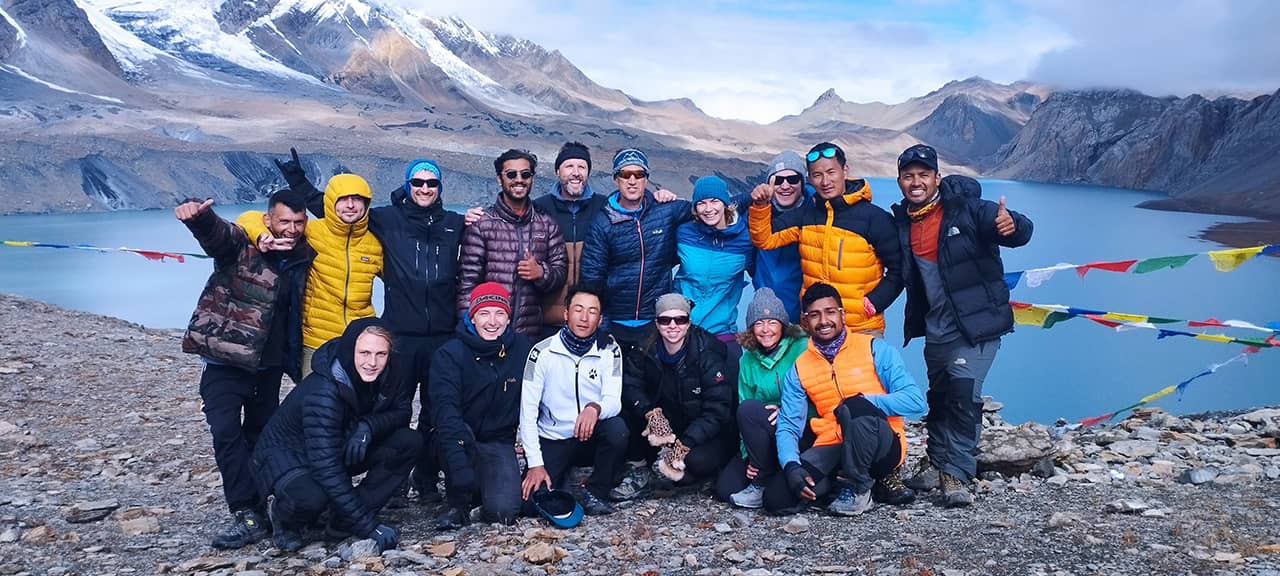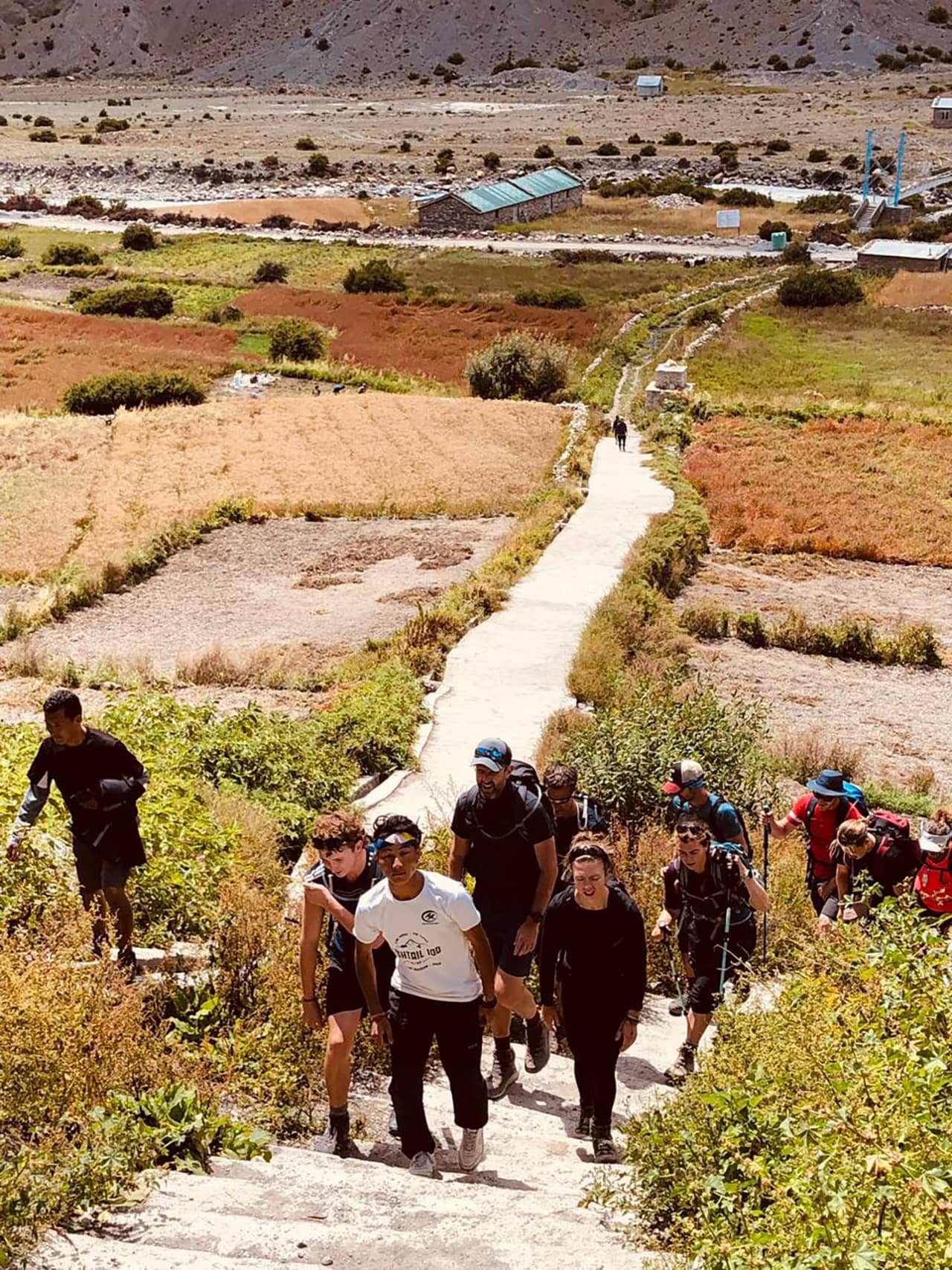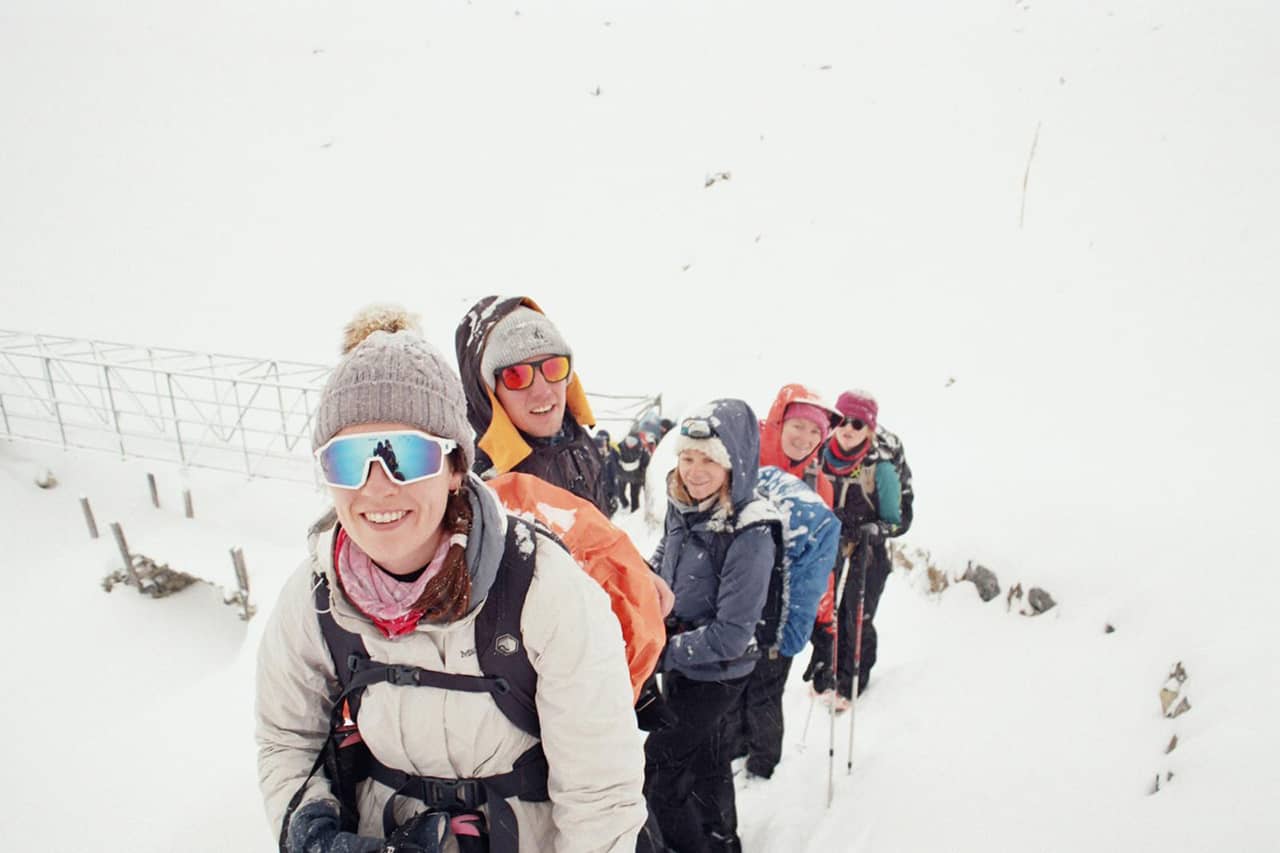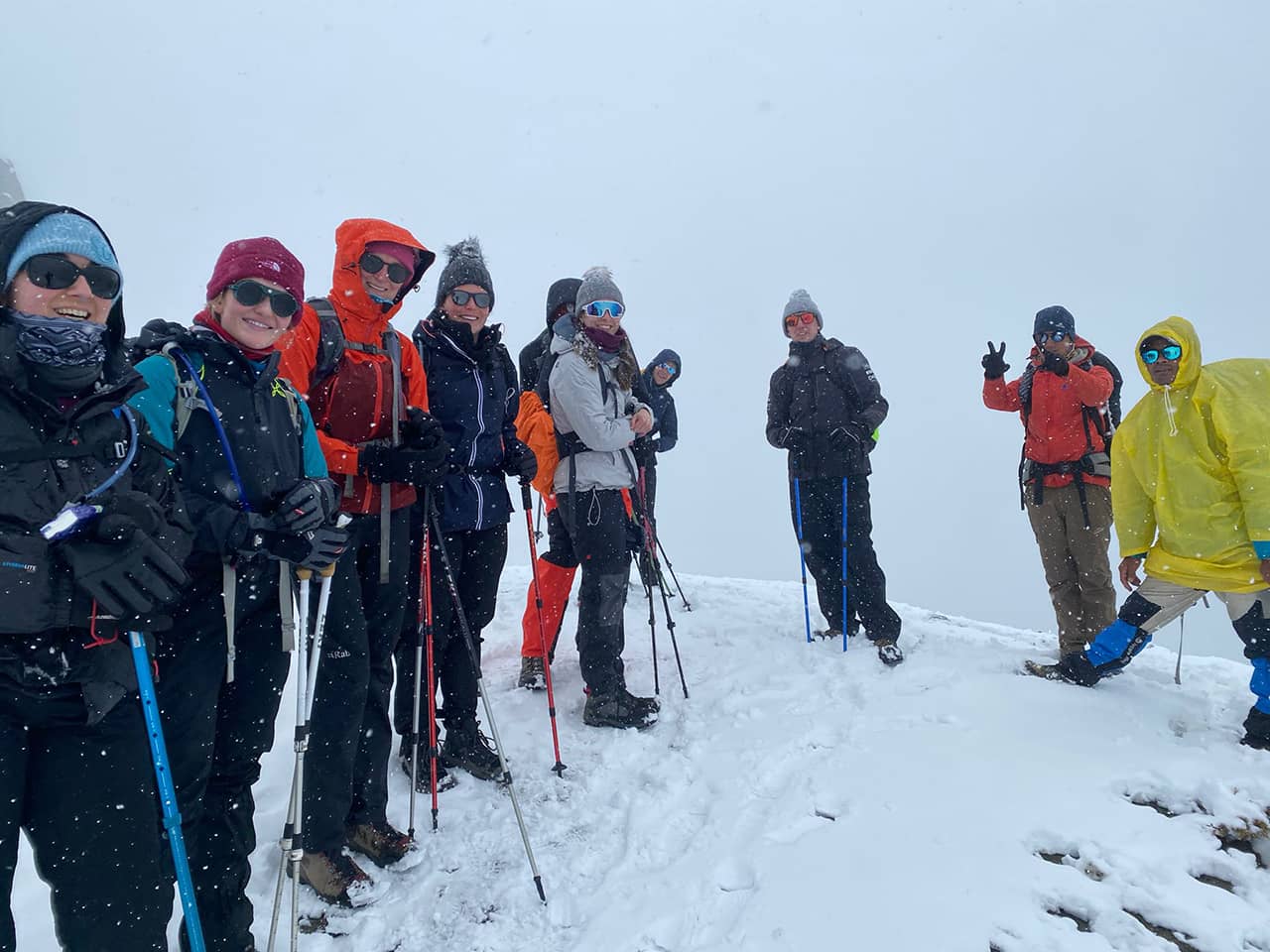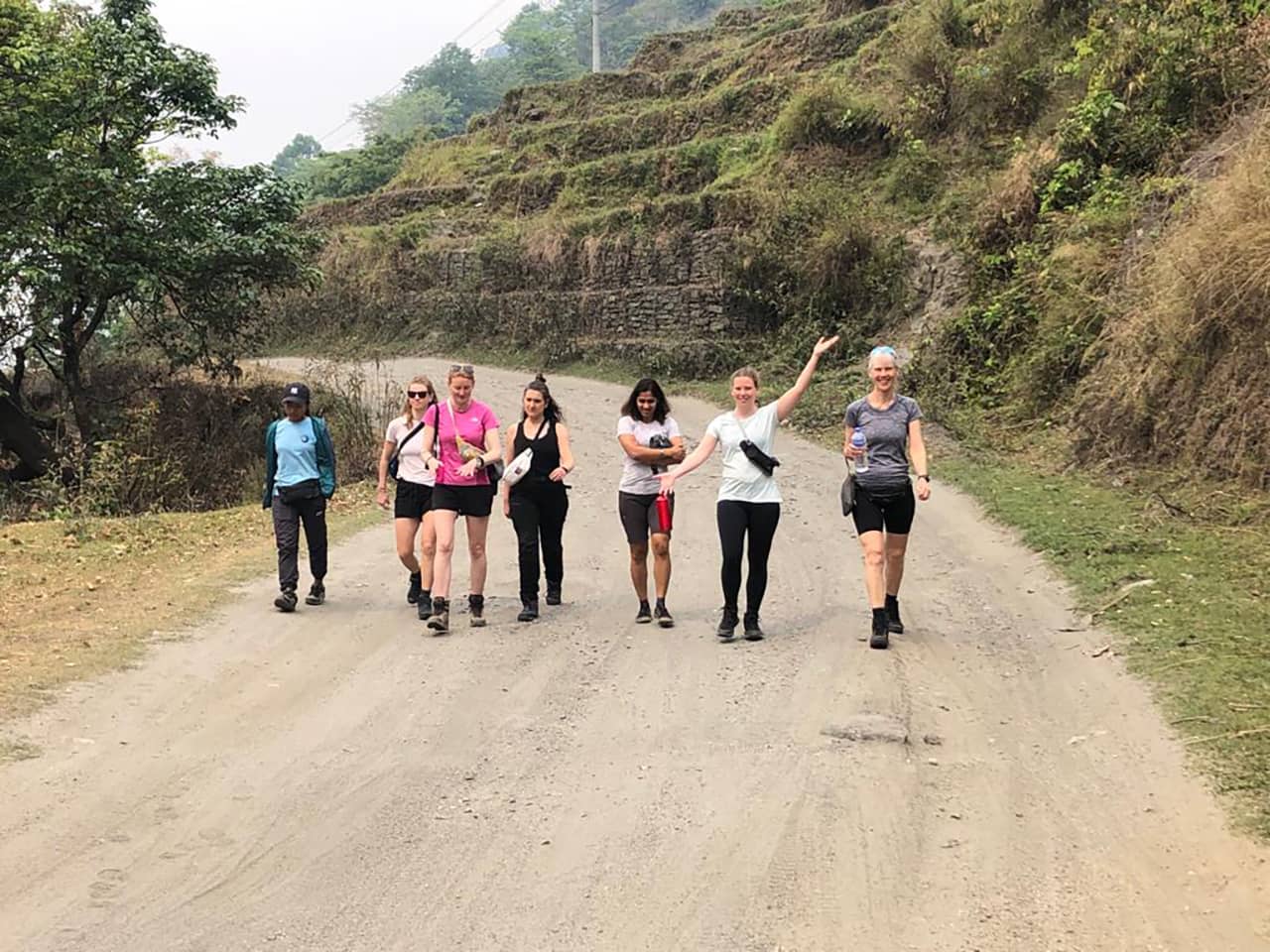Contact Info
Annapurna Sanctuary Trek Popular
INFORMATIONS
Annapurna Sanctuary Trek Overview
The Annapurna Sanctuary Trek is one of the most popular treks in Nepal. It is a great choice for people who want to explore the beautiful mountains, forests, and local villages. This trek takes you into the heart of the Annapurna region, where you will experience stunning views of tall peaks, including Annapurna South, Machapuchare, and Hiunchuli.
The trek starts from Pokhara, a city known for its peaceful lakes and lovely views of the mountains. From there, you will walk through small villages, lush forests, and terraced fields. Along the way, you will get to see the unique lifestyle of the local people, mostly from the Gurung and Magar communities. These villagers have their own traditions and speak their own language. It’s a great opportunity to learn about their culture.
As you move higher into the mountains, the environment changes. You will pass through rhodo-dendron forests, where the flowers bloom in bright colors during spring, and cross over rivers using suspension bridges. You may also spot different types of wildlife, like birds and monkeys, if you are lucky One of the most exciting parts of the trek is reaching the Annapurna Base Camp. At the base camp, you will be surrounded by high, snow-covered peaks. It’s a magical feeling to be so close to these giant mountains. The view from the camp is one of the best in the world.
The trek is usually done in 7 to 15 days depending on your pace. It is considered a moderate trek, so it is perfect for beginners and experienced trekkers. You don’t need to be a super athlete to do this trek, but you should be in good health and have some stamina.
Along the way, you will stay in tea houses that provide simple meals and cozy rooms. These tea houses are a great way to meet other trekkers and share experiences Overall, the Annapurna Sanctuary Trek is a fantastic journey. It offers beautiful nature, an opportunity to connect with locals, and a chance to experience the grandeur of the Himalayas up close.
Trek Duration: 15 days
The Annapurna Sanctuary Trek is a classic Himalayan adventure that takes you to the heart of the Annapurna range, offering breathtaking views of Annapurna I (8,091m) Machhapuchhre (6,993m), and other beautiful mountains range.
The Annapurna Base Camp (ABC) Trek is one of Nepal's most popular and scenic treks, offering stunning views of the Annapurna mountain range. Here’s a brief summary of the trek:
- The trek begins in Pokhara, a picturesque city, and follows a route through the Pohra Valley into the heart of the Annapurna Massif. The journey takes you through lush forests, quaint villages, terraced fields, and dramatic landscapes.
- Ghorepani Poon Hill: A popular viewpoint for stunning sunrise views over Annapurna, Dhaulagiri, and Machapuchare.
- Annapurna Base Camp: The ultimate destination, providing a breathtaking panoramic view of Annapurna I, Machapuchare, and other peaks.
- Cultural Experience: You’ll pass through traditional Gurung and Magar villages, offering insight into local culture and hospitality.
- Flora and Fauna: The trek passes through various ecosystems, from subtropical forests to alpine meadows. This trek offers a perfect mix of adventure cultural exposure, and natural beauty The Annapurna Base Camp (ABC) Trek, has a fascinating history and a significant place in the trekking world. Here are some historical highlights:
Early Exploration and Discovery:
The Annapurna region, including the Annapurna Sanctuary, was first explored by Westerners in the early 20th century. The first recorded expedition to the Annapurna massif was in 1950 when a French team led by Maurice Herzog successfully reached Annapurna I (8,091m)This achievement marked the first ascent of an 8,000-meter peak.
The Annapurna Base Camp itself became a destination for trekkers in the 1970s following the increasing interest in the region due to the success of climbing expeditions and the opening up of Nepal to international tourism.
Development of Trekking Routes:
The development of trekking routes in the Annapurna region began with the establishment of the Annapurna Conservation Area Project (ACAP) in 1986. The goal of ACAP was to preserve the environment, culture, and biodiversity of the region while promoting sustainable tourism. The Annapurna Sanctuary Trek is now part of this protected area, and trekkers can experience both the natural beauty and the cultural heritage of the region.
The Annapurna Sanctuary:
The Annapurna Sanctuary is a natural basin surrounded by the peaks of Annapurna, Machapuchare and other prominent mountains. The region is considered sacred by local people, particularly the Gurung and Magar communities. In fact, the word “sanctuary” refers to both the religious significance and the natural protection the area offers.
Cultural Significance:
The trek not only takes trekkers through stunning natural landscapes but also through villages with deep cultural significance. The Gurung people, who live in the foothills of the Annapurna region have a long history of working as soldiers in the British and Indian armies. Their villages, customs, and festivals, such as Tihar and Dashain, are a core part of the trekking experience.
The Impact of Tourism
Since the 1980s the Annapurna Sanctuary Trek has become one of Nepal's most popular trekking routes. The growth of tourism has helped improve infrastructure and bring economic benefits to the region. However, it has also brought challenges such as the need to manage environmental concerns and the preservation of local culture amidst increasing numbers of trekkers.
Annapurna Sanctuary Trek Highlights:
- Stunning Mountain Views: From the start to the end, you’ll get breathtaking views of the Annapurna range, including peaks like Annapurna South, Machapuchare (Fishtail), and Hiunchuli.
- Diverse Landscapes: You’ll walk through beautiful forests, terraced fields, and charming villages. The scenery changes from lush greenery to snow-covered peaks as you go higher.
- Annapurna Base Camp: The highlight of the trek is reaching the Annapurna Base Camp. Surrounded by giant mountains, it feels like you’re in the heart of the Himalayas.
- Local Culture: You’ll pass through small villages where you can meet friendly locals from thee. Gorong and Magar Communities. It’s a great chance to learn abo their culture and traditions.
- Wildlife Spotting: As you walk through forests and fields, you might see wildlife like monkeys, birds, and even the rare red panda if you’re lucky.
- Rhodo-dendron Forests: In spring, the forests are covered in colorful rhodo-dendron flowers, creating a stunning display of pink, red, and white blossoms.
- Peaceful Tea Houses: During the trek you’ll stay in cozy tea houses, where you can relax, enjoy traditional Nepali food, and meet fellow trekkers.
- Suspension Bridges: You’ll cross several suspension bridges hanging over deep valleys and rivers, adding a thrilling touch to your trek.
- Mild Difficulty: The Annapurna Sanctuary Trek is perfect for beginners or anyone looking for a moderate challenge. It’s not too tough, but it still gives you an amazing adventure.
- Vibrant Sunrise Views: If you wake up early, you can watch the sun rise over the mountains, turning the peaks into golden giants. It's a moment you won’t forget.
Itinerary
On Day 1 you’ll arrive in Kathmandu the capital city of Nepal. Kathmandu is a busy and exciting city with a mix of old and new places to see. After you arrive at the airport, you’ll be welcomed by your trek guide or tour operator. They will help you with everything from getting to your hotel to making sure you are ready for the trek ahead.
Once you’re settled in your hotel, you’ll have some time to rest after your journey. In the afternoon, your guide will meet with you to give a briefing about the trek. They will explain the route, what to expect each day, and make sure you have everything you need for the adventure.
Kathmandu is also a great place to explore before the trek begins. If you have time, you can visit famous places like Swayambhunath Stupa (also known as the Monkey Temple) or Durbar Square. These are important cultural sites that show Nepal’s rich history and traditions. After a relaxing day, you will rest and get ready for the exciting journey to Annapurna starting the next day.
On Day 2 you will leave Kathmandu and head to Pokhara, a beautiful city known for its lakes and mountain views. You can either choose to take a scenic drive or a quick flight to Pokhara.
If you take the drive, it will take around 6 to 7 hours. You will travel through hilly roads, passing by small towns and farms. The drive offers lovely views of rivers and green fields, making the journey enjoyable.
If you prefer to fly, the flight will be much shorter, taking about 25 minutes. From the plane, you can see the beautiful Himalayan mountains, which is a great preview of what is to come on your trek Once you arrive in Pokhara, you will check into your hotel and have some free time to relax and explore the city. Pokhara is a peaceful place with a lake called Phewa Lake, where you can take a boat ride or walk around the lake. You can also visit a few shops to buy any last-minute supplies for your trek. After spending the day in Pokhara, you will rest and prepare for the start of your trek the next day.
On Day 3 you will start your journey by driving from Pokhara to Naya Pul, which takes about 1 to 1.5 hours. Naya Pul is a small town where your trek will officially begin. From Naya Pul, you will drive a bit more to Ulleri, a village located at a higher altitude.
After reaching Ulleri, you will start your trek to Banthanti. The walk from Ulleri to Banthanti is about 4 to 5 hours. During this trek you will pass through lush forests filled with tall trees and sometimes rhododendron flowers, especially in spring. The trail is a mix of stone steps and dirt paths that go up and down As you walk, you will get a chance to see the beautiful mountain views and the peaceful surroundings. You will pass by small villages, where you may see local people working on their farms or caring for animals Finally you will reach Banthanti, a small and quiet village. Here, you will stay in a tea house and rest for the night, enjoying a warm meal and getting ready for the next day's adventure.
On Day 4 you will continue your trek from Banthanti to Gorepani. The walk will take around 5 to 6 hours. As you walk you will pass through dense forests filled with tall trees and colorful rhododendron flowers. In the spring, these flowers make the forest look very beautiful.
The path is mostly uphill, but you can take breaks whenever you need. Along the way, you will see small villages, and sometimes you might meet local people carrying heavy loads or tending to their animals. The higher you go, the more stunning the mountain views become, and you will feel like you are getting closer to the Himalayas.
Gorepani is a popular stop for trekkers. It is a small village located at a higher altitude, where you will rest for the night. After reaching Gorepani, you can enjoy a warm meal at one of the tea houses. The evening will be a great time to relax and rest, as tomorrow’s journey includes a very special sunrise hike. You can also look forward to a quiet and peaceful night in this village, surrounded by the beauty of the mountains.
On Day 5 you will wake up early to hike up to Poon Hill, which is at an altitude of 3,210 meters. The hike to Poon Hill takes about 45 minutes to an hour. It is a bit challenging because of the steep stairs, but the reward is worth it. From the top, you will get a stunning view of the Himalayan mountains, including Annapurna, Dhaulagiri, and Machapuchare (Fishtail). The early morning light makes the snow-covered peaks look golden, which is a beautiful sight.
After spending some time at Poon Hill, you will return to Gorepani for breakfast. Then, you will continue your trek down to Chule which will take around 5 to 6 hours. The walk from Gorepani to Chule is mostly downhill, passing through forests and small villages. Along the way, you may see local people working on their farms and animals grazing in the fields.
When you arrive in Chule you will rest for the night in a tea house. It will be a peaceful place to relax after a long day of trekking. The views of the mountains and the village surroundings will make your evening special.
On Day 6 you will leave Chule and start trekking towards Lower Sinuwa. The trek will take around 5 to 6 hours. The path starts with a gentle descent and then slowly begins to climb higher. As you walk, you will pass through forests filled with tall trees and sometimes flowers like rhododendrons.
During the trek, you will come across small villages and see local people working on their farms. The sound of birds and the peaceful atmosphere will make the walk enjoyable. As you get higher, you will begin to see more mountain views in the distance. These views get better as you continue your journey.
After a good day of walking, you will arrive in Lower Sinuwa, a quiet village where you can rest for the night. The village is surrounded by beautiful nature, and it is a great place to relax after a long day. You will stay in a cozy tea house, where you can enjoy a warm meal and get ready for the next day’s adventure. This will be a peaceful and calm evening, perfect for resting your body for the next part of your trek.
On Day 7 you will continue your trek from Lower Sinuwa to Bamboo, a small village located at 2,345 meters. The walk will take around 5 to 6 hours. You will begin by walking downhill and then gradually climb through the forest. As you walk you will pass through thick bamboo forests, which is how the village got its name.
Along the way, you will see beautiful views of the surrounding mountains and hear the sounds of nature. The path can be a bit steep in some places, but the cool shade of the trees and the fresh mountain air will make the trek more enjoyable. You might also see local people and animals as you walk through small villages and pastures Once you reach Bamboo, you can rest in a tea house and enjoy a warm meal. The village is peaceful, and you will have time to relax and take in the beauty of the surroundings. After a long day of trekking, it will be a great place to unwind and prepare for the next part of your adventure.
On Day 8 you will leave Bamboo and start your trek to Himalaya, which is at an altitude of 2,900 meters. The trek will take about 5 to 6 hours. As you walk, the trail gets steeper, and you will be surrounded by tall trees and bamboo forests. The forest is quiet and peaceful, and you may hear the sound of birds and the breeze through the trees.
As you continue, you will begin to notice the landscape changing. The trees become shorter, and the views of the mountains around you start to get clearer. You will walk through small villages, and you might see local people working on the fields or herding animals.
Once you reach Himalaya, you will be able to see the Annapurna Range and other beautiful mountains in the distance. It will be a great place to relax and enjoy the views. In the evening, you will stay in a tea house and have a warm meal. The peaceful environment and the stunning surroundings will help you unwind after a long day of trekking. You will rest here, ready for the next part of your adventure.
On Day 9 you will leave Himalaya and start your trek to Machapuchhre Base Camp, which is at an altitude of 3,700 meters. This part of the trek will take around 5 to 6 hours. The trail gets a little more challenging as you get closer to the base camp, but the beautiful views will keep you motivated As you walk, you will pass through rocky paths and alpine meadows, and you may even see some yaks and other animals along the way. The views of the Machapuchhre Mountain, also called Fishtail Mountain, will get clearer as you climb higher. The mountain looks very beautiful, with its unique shape and snow-covered peaks.
Once you reach Machapuchhre Base Camp, you will be surrounded by high mountains and stunning views. It will feel like you are right in the heart of the Himalayas. After a long day of trekking, you can relax and enjoy the peaceful atmosphere. You will stay in a tea house, where you can have a warm meal and rest. The views here are amazing, and you will feel proud of how far you’ve come on your journey.
On Day 10 you will continue your trek from Machapuchhre Base Camp to Annapurna Base Camp (ABC), which is at an altitude of 4,130 meters. This will take about 4 to 5 hours. The trail is a bit steeper, but the view of the Annapurna Range and surrounding peaks will keep you excited.
As you walk, you will pass through rocky paths and small grassy areas. The higher you go, the more beautiful the landscape becomes. You will see snow-capped mountains all around you, and the fresh air will feel even colder as you gain altitude. The trek is a bit harder, but the journey is worth it because of the stunning views of the mountains and valleys.
Once you reach Annapurna Base Camp, you will be surrounded by some of the tallest peaks in the world. It is a beautiful place where you can rest and enjoy the views. The base camp feels peaceful and quiet, and it is a great place to relax after your hard work. You will stay in a tea house and have a warm meal while taking in the amazing surroundings. This is the highlight of the trek, and you will feel proud to have reached such a special place.
On Day 11 you will begin your trek from Annapurna Base Camp back to Bamboo, which is at an altitude of 2,345 meters. The trek will take around 6 to 7 hours. Since today’s path is mostly downhill, the walk will be easier, but it still requires some effort. You will retrace your steps and pass through the rocky paths and forests that you crossed on your way up.
As you walk down, you will notice how the landscape changes again. The trees become taller, and you will pass through areas with lush vegetation. The weather will feel warmer as you descend, and you may see local people working in the fields or moving animals along the trail When you reach Bamboo, you can rest and relax in a tea house. This village is quiet and peaceful, offering a nice place to unwind after a day of trekking. You will enjoy a warm meal and take in the beautiful surroundings. It will be a good chance to rest and get ready for the next part of your journey.
On Day 12 you will start your trek from Bamboo to Juno Danda, which is at an altitude of 2,300 meters. The trek will take around 5 to 6 hours. The path will take you through beautiful forests and terraced fields. As you walk, you will pass small villages where you might see local people working on their farms or walking with animals.
The trek will be a bit of a climb in some places, but the cool shade of the trees and the peaceful atmosphere will make it enjoyable. You will see great views of the surrounding mountains and valleys along the way. The higher you go, the more you will see of the mountains in the distance When you reach Juno Danda, you will be able to relax in a tea house and enjoy the quiet surroundings. It is a small village and the area is calm, making it a nice place to rest after a day of walking. You will have a warm meal and take time to relax, ready for the next part of your trek. The evening will be peaceful, with beautiful mountain views around you.
On Day 13 you will start your trek from Juno Danda to Siwai, which is at an altitude of 820 meters. This part of the trek will take about 3 to 4 hours. The trail will be mostly downhill, passing through small villages, terraced fields, and beautiful landscapes. As you walk you will notice the temperature getting warmer, and you will see more signs of village life.
When you reach Siwai, you will take a short drive to Pokhara, which will take around 2 hours. Pokhara is a beautiful city where you can relax and enjoy the views of Phewa Lake and the Himalayas. It is a great place to unwind after your trek.
In the evening, you will have a special dinner with the local crew who helped you during the trek. This will be a chance to thank them for their hard work and to share your trekking experience. The dinner will be a warm and friendly celebration of the journey you have completed. You can enjoy some delicious local food and reflect on the amazing adventure you had in the Annapurna region. It will be a perfect end to a wonderful trip.
On Day 14 you will leave Pokhara and head back to Kathmandu, which is at an altitude of 1,400 meters. You have two options for traveling: you can either take a flight or go by drive. If you choose to fly the flight will take about 25 to 30 minutes, and you will have beautiful views of the mountains as you fly over the landscape. If you decide to drive, it will take about 6 to 7 hours to reach Kathmandu, passing through villages and scenic countryside.
Once you arrive in Kathmandu, you will have the rest of the day to relax and explore the city. Kathmandu is a busy and vibrant place filled with temples, markets, and colorful streets. You can visit some of the famous sites like Swayambhunath Stupa (Monkey Temple) or Durbar Square if you have time In the evening, you will have time to reflect on your trek and the amazing experiences you had during the Annapurna Sanctuary trek. It will be a great chance to relax and enjoy the city before you prepare for your departure or continue your travels
On Day 15 it is time to say goodbye to Kathmandu and the beautiful Annapurna region. Depending on your travel plans, you will be transferred to the Kathmandu airport for your flight home or to your next destination. The airport is just a short drive from the city and you can enjoy the final views of the city on your way there.
If you have some extra time before your flight, you can visit nearby shops or cafes to do some last-minute shopping or enjoy a final cup of tea. Kathmandu is full of vibrant markets where you can find souvenirs, local crafts, and gifts to take home.
As you leave, you will carry with you the memories of your amazing trek through the Annapurna Sanctuary. From the stunning mountain views to the friendly people you met along the way, this journey will be something you will never forget. You will feel proud of the adventure you completed and the new experiences you gained This is the end of your trek, and you will be ready to return home with wonderful memories of the beautiful Himalayas and your time in Nepal.
Price Includes
- Airport pick-up and drop-off in a private vehicle
- Ground transportation or Flight To pokhara
- Accommodation (twin-sharing Room) during the Trek
- English speaking Trek Leader
- Daily meals (breakfast, lunch, and dinner and 3 cup tea during the trek)
- Trekking permits National Park fee
- Experienced porter (1 porter for every 2 trekkers, carrying up to 15kg per person)
- Every 4 Trekkers 1 assistant guide
- Safety & Equipment
- First Aid kit
- Oxygen cylinder and oximeter (for high-altitude treks)
Price Excludes
- International Flights
- Nepal Visa Fees
- Overstay fines or additional visa extensions.
- Travel & Medical Insurance. Mandatory for all trekkers and climbers.
- Trip cancellations, lost baggage, or delays.
- Personal Trekking Equipment & Gear
- Gear rental if not bringing personal equipment.
- Meals in Kathmandu & Pokhara
- Breakfast, lunch, and dinner while in cities.
- Extra Beverages, Snacks & Bottled Water
- Additional Accommodation
- Hotel upgrades beyond the included standard.
- Emergency Evacuation & Helicopter Rescue
- Tips & Gratuities
- Personal Expenses : Souvenirs, laundry, internet, and phone calls.
- Hot showers and battery charging at teahouse
- Additional Activities : Sightseeing tours, entrance fees, and personal excursions. Adventure sports like paragliding, rafting, or bungee jumping.
- For any specific exclusions related to your trekking or expedition package, feel free to ask. We're happy to assist with recommendations!
Tipping Ratio
It is customary in Nepal to tip your lead guides and files crew . You can give tips to your lead guide at the end of your trip, which will then be shared with the whole team.As part of our transparency initiative, the lead guide will distribute the tips to the guides and porters in your presence.A good rule of thumb is to budget around $ 120 USD per client you need to collect tips, and although the amount you give is entirely your choice.
Kit Lists:
.jpg)
Notes:
The Annapurna Sanctuary Trek is a stunning journey that takes you into the heart of the Annapurna Massif. Surrounded by towering Himalayan peaks, the trek leads to Annapurna Base Camp (4,130m), a natural amphitheater of snow-capped mountains
Annapurna Base Camp (ABC) 4,130m, breathtaking 360° views of peaks.
Machapuchare Base Camp (MBC) Sacred Fishtail Peak viewpoint.
Hot Springs at Jhinu Danda Natural thermal pools to relax.
Gurung & Magar Culture Warm hospitality in villages like Ghandruk & Chhomrong.
Lush Rhododendron Forests Especially colorful in spring (March April).
Himalayan Flora & Fauna Langurs, pheasants, orchids, and more
Route Option Via Ghorepani & Poon Hill – Longer but includes beautiful sunrise.
Direct Route via Chhomrong Shorter, faster access to ABC.
Combine with Mardi Himal Trek for extended adventure.
Difficulty Level
Moderate Suitable for fit trekkers with or without prior experience.
Altitude is high but less extreme compared to Everest region.
Acclimatization days and gradual ascent help reduce AMS risk.
Best Seasons
Spring (March May) Warm, clear skies, rhododendrons bloom.
Autumn (Sept Nov) Clear views, stable weather.
Winter (Dec Feb) Cold but less crowded, great for photography.
Monsoon (June Aug) Risk of landslides, leeches, clouded views.
Accommodation & Meals
Teahouses and lodges available in every village.
Meals include Nepali dal bhat, soups, noodles, momos, and basic Western food.
Hot showers and charging available (with extra cost in higher altitudes).
Essential Gear
Warm layers, down jacket, rain gear
Sleeping bag (-10°C recommended)
Trekking poles, headlamp, water filter/tablets
Basic first-aid kit, personal medicines
Travel insurance (with helicopter rescue coverage
Emergency Option
Helicopter evacuation is possible from ABC or nearby if needed (weather dependent).
Always carry travel insurance with emergency evacuation coverage.
Client Review 0 reviews
No reviews yet for this package. Be the first to review!

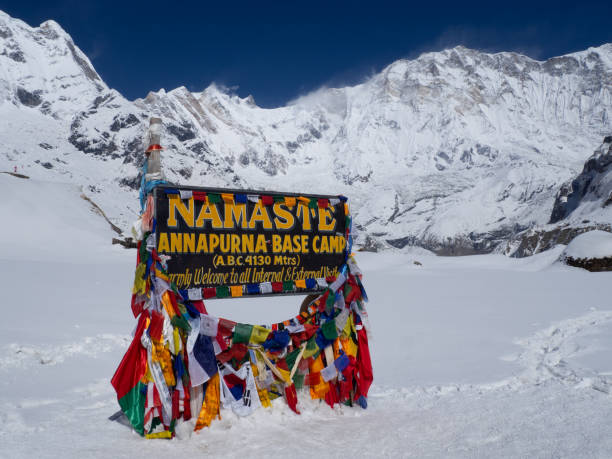
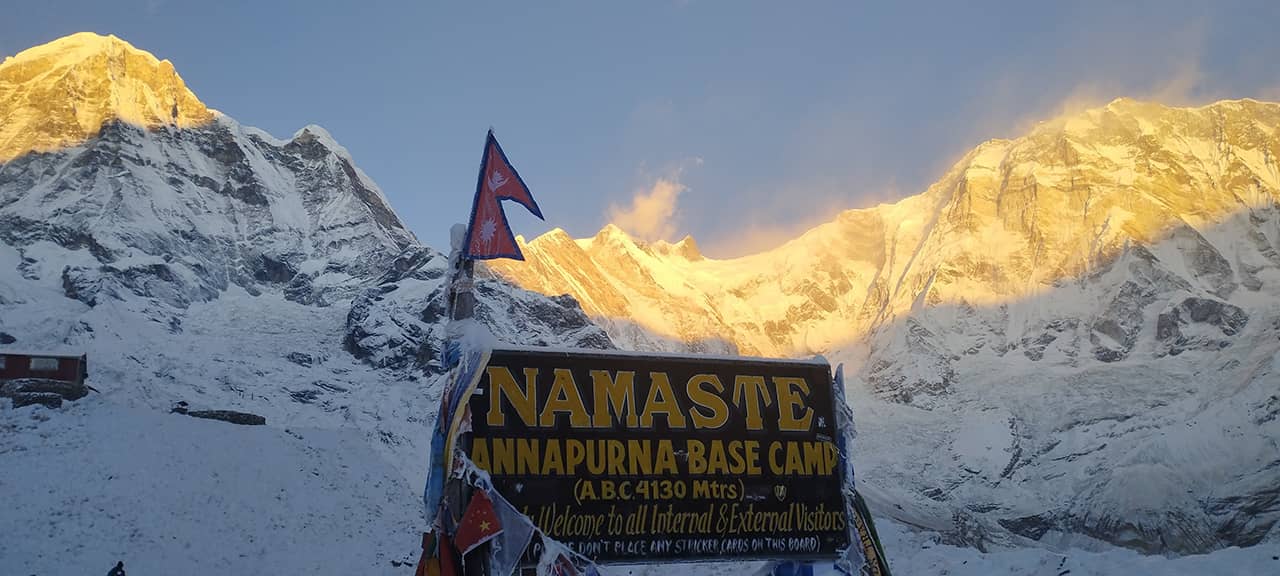
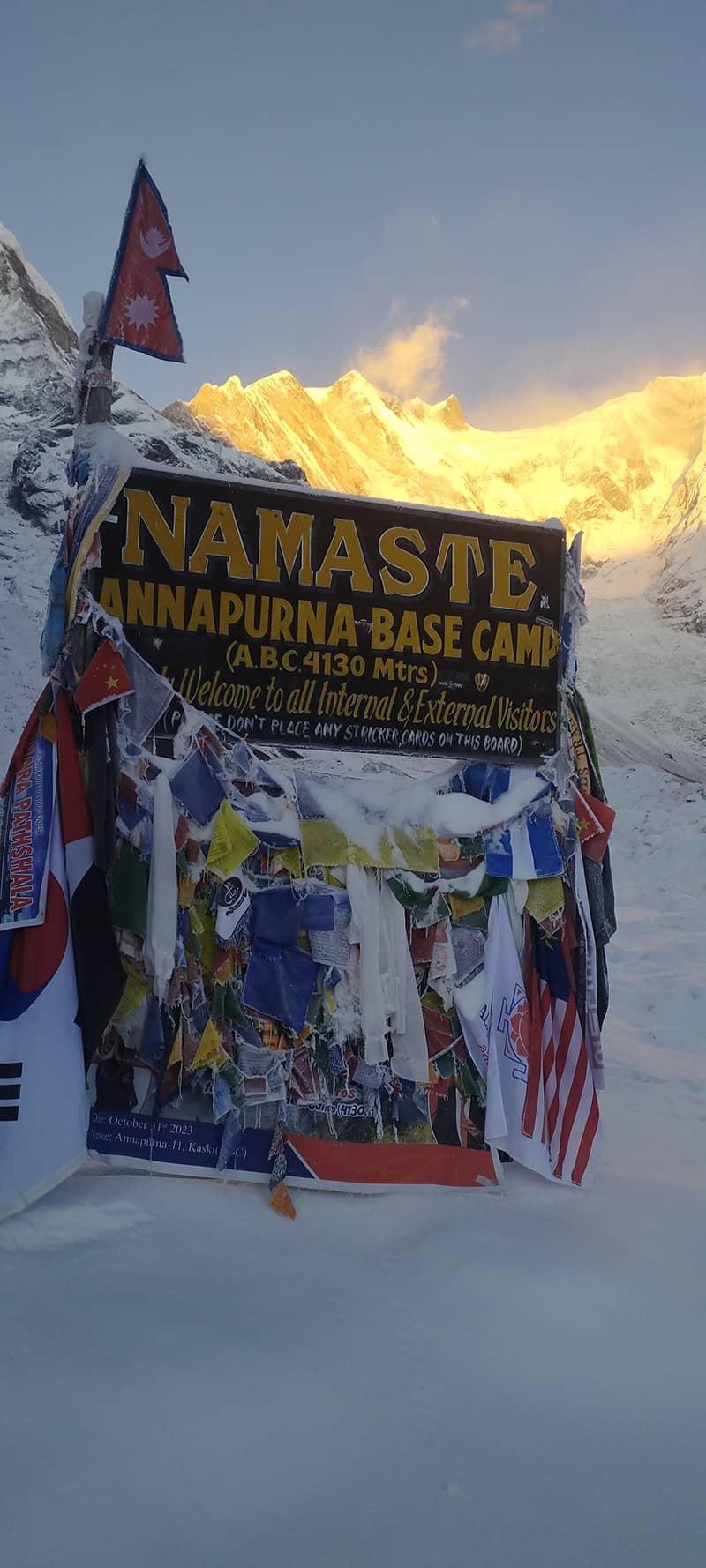
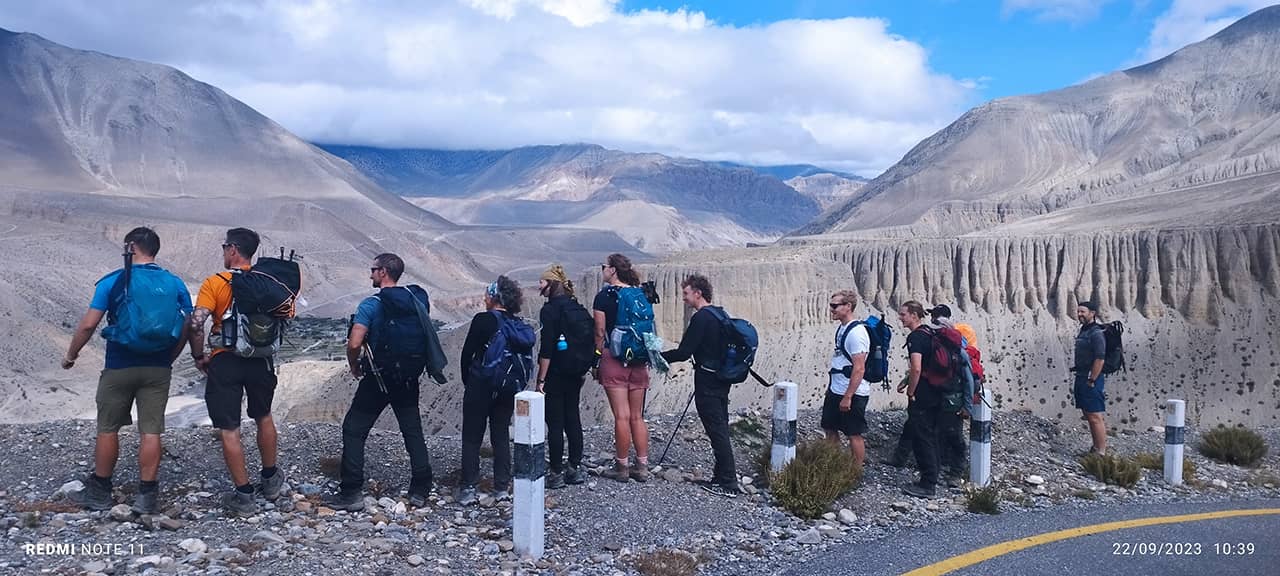
.jpg)
